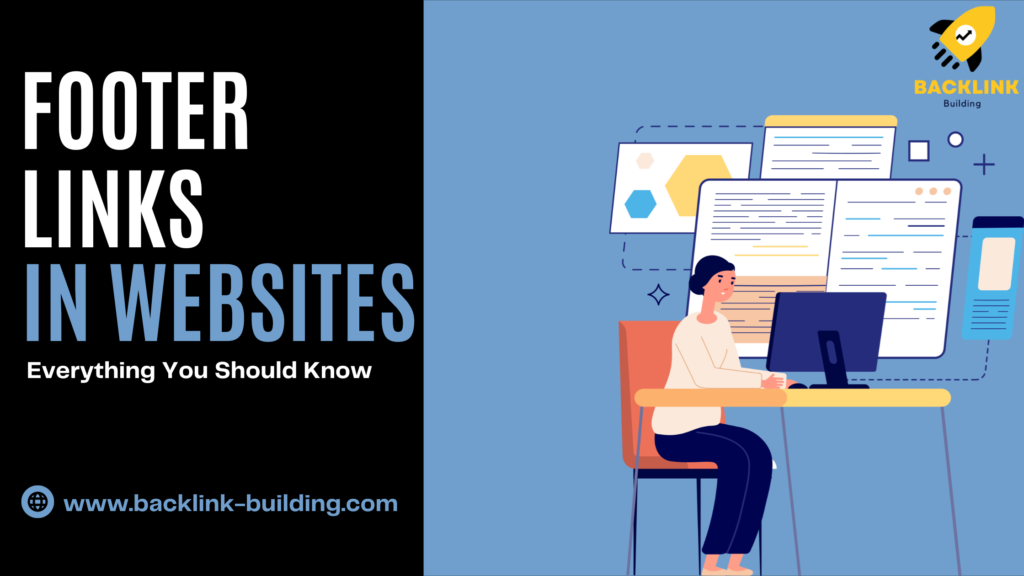
We keep on building links with various techniques present in the SEO industry, and we forget the primary and most important thing: Footer links. These links are generally put at the bottom of our website pages. Footer links used to be very popular a few years ago and were considered valuable assets for any website. These links are generally less visible to users but still clickable.
Footer links are often an afterthought for many website owners. This blog post will discuss everything you need to know about links. We will answer common questions such as “What is a footer?” and “Does the footer link still matter in 2025?” Additionally, we will provide tips on creating effective links and what to include in them.
Footer links may not be the most popular element on a website, but they can still be a powerful tool for SEO and driving traffic. So, to get to know much about these links, keep reading.
What Is A Footer Of A Website?
A website’s footer is generally an area found at the bottom of web pages that contains additional information about the site, such as the copyright notice or contact information. Footers often display navigational links to other parts of the site.
What Are Footer Links?
Footer links are the hyperlinks present in the Footer of a website. These links are generally less visible to users but still clickable.
Earlier, these links used to be valuable assets for any website because they were less visible to users but still clickable. However, over time, Google has devalued footer links as a ranking factor because spammers often abuse them.
Despite this, these links can still benefit your website if used correctly. For example, if you have a blog post getting a lot of traction, you can include a link to it in your Footer so visitors can easily find it.
Benefits And Drawbacks Of Footer Links
There are both pros and cons to these links on your website.
Some Of The Benefits Of Footer Links Include:
- It can help increase the number of pages indexed by search engines.
- Boost the authority of the linked pages.
- It can help visitors navigate your website more easily.
- They can increase the number of inbound links to your website.
- Overall, it can improve the SEO of your website.
Some Of The Drawbacks Of Footer Links Include:
- Users may ignore these links if they are not well-designed.
- Search engines may devalue these links if spammers abuse them.
- It may make your website look cluttered if there are too many.
- It may not be necessary if your website has a good navigation menu.
- Footer links may decrease your website’s click-through rate (CTR) if irrelevant to the user’s needs.
Overall, it is up to you to decide whether footer links suit your website. They can be a helpful tool for SEO and navigation if used correctly. However, they can do more harm than good if abused or not well-designed.
Do Footer Links Still Matter In 2025?
The answer is YES! These links are still important in 2025 because they can help improve the user experience on your website.
Additionally, footer links can also be a valuable asset for SEO. While Google may not give as much weight to these links as to other links, they can still help improve your website’s link profile.
To sum it up, the footer link still matters, and you should include it on your website. However, there are a few things you need to keep in mind when creating a footer link.
Here Are Some Tips For Creating Footer Links:
- These links should be relevant to the page they are on. For example, if you have a blog post about SEO, your footer link should go to a page about SEO.
- Who should place these links on high-quality websites? If you’re including a footer link on your site, make sure it’s from a reputable website relevant to your industry.
- These links should not be abused. Google has said that too many links in the Footer can be seen as spammy, so use them sparingly.
- It should be included in a healthy link profile. A healthy link profile has a mix of links, such as do-follow and no-follow links.
- It should be used to improve the user experience. Remember, SEO aims to improve the user experience, so make sure your footer links are helping visitors find what they’re looking for.
Now that we’ve answered the question, “Do footer links still matter,” let’s look at some different types of footer links.
Types Of Footer Links
Many footer links exist, but we’ve compiled a list of the ten most common ones.
Copyright Links
These are the most common types of footer links. They include the copyright symbol © and the year and a link to the website’s terms and conditions page.
Copyright is a written notice that gives the owner of a creative work the exclusive right to use and distribute that work. And vice versa, i.e., to deter anyone from stealing or using it without permission.
Privacy Policy Links
In some countries, such as the European Union, privacy policy links are required by law. They usually lead to a page explaining how the website collects and uses personal data.
Privacy Policy agreements are mandatory if a website collects personal data from users, like their email addresses or payment information. For this reason, drafting a legally compliant Privacy Policy is essential. Not only will this satisfy the legal requirement — but it will also meet most consumers’ expectations of being safe.
Affiliate Footer Links
Affiliate links are used to promote products or services on behalf of another company. They usually include a tracking code so the affiliate can earn a commission if someone clicks on the link and makes a purchase.
Link Exchange Links
Link exchange Footer links are when two websites agree to put each other’s links in their Footers. This used to be a common practice, but it’s now considered bad for SEO.
Resource Links
Resource footer links are links to websites or resources that may be helpful to the website’s visitors. For example, if you have a blog about gardening, you might include a link to a gardening resource website in your Footer or resources, such as articles, blog posts, or infographics.
Contact Links
Every website owner wants their target audience to contact them quickly. For that reason, Contact links usually go to a page with the website’s contact information, such as an email address or phone number.
Social Media Links
Social media is another way to increase your website’s SEO performance. It’s also great to increase followers or subscribers across your platforms. 75% of the websites include social media in their footers.
Newsletter Signup Links
Ideally, Everyone wants to present a Newsletter form to a visitor who understands the value of your content and wants more. Every visitor who has scrolled to the bottom of your web page can be a targeted audience.
Newsletter signup forms are often placed in the Footer of websites so visitors can subscribe to receive updates.
Sitemap Links
Sitemaps are XML files that contain a list of all the pages on a website. They are used to help search engines index websites more efficiently. According to google, search engines use these XML files to better crawl websites, huge and content-rich sites. That’s why providing a link to these files in your Footer is considered a best practice for SEO.
Breadcrumb Links
Breadcrumbs are links that show the path a visitor took to get to the current page. It’s a helpful way for visitors to navigate websites and can also help with SEO. For example, if someone is on a product page, the breadcrumb might say “Home > Products > Product Name.”
Four Things To Know About Footer Links
Now that we’ve gone over the different footer links let’s look at some things you should know about them.
Footer Link Click-Through Rates (CTRs) Are Low
The average CTR for a footer link is 0.15%. This means that for every 1000 people who visit your website, only 15 will click on the footer link.
Most Footer Links Get Devalued by Google
Google has said that they devalue most Footer links. They don’t count as much towards improving your website’s SEO.
Footer Links Can Take Pages Beyond A “Healthy” Link Total
A healthy link profile has a mix of links, such as dofollow and nofollow links. These links are usually followed, reducing the balance of a healthy link profile.
Creating Footer Links Can Be Time-Consuming
Footer links are often created manually, which can be time-consuming. If you create these links, ensure you have the time to do it right.
Is Footer Backlinking Considered Spam?
The Footer area of a website is often full of links that are not relevant to the content on the page. These links are generally low-quality and not valuable to the reader. For these reasons, Footer backlinks are often considered spam by Google.
Do Footer Links Have An Impact On SEO?
Footer links are often devalued by Google and are not as effective as they once were. But, still, they can have a small impact on your website’s SEO. However, they are generally not as valuable as other links, such as in-content links. But, they can still be a helpful way to improve your website’s SEO. If you create a Footer link, be sure to do it manually and take the time to do it right.
Google’s Point On Footer Links
In March 2016, Google’s John Mueller was asked if the Footer link carried any weight. His response was:
“I wouldn’t expect Footer link to carry as much weight as other links on the page.” He also said that Google devalues Footer link because they are “easy to manipulate.”
These links are not as valuable as other links on the page, but they can still be helpful for SEO. If you choose to include these links on your website, ensure they are high-quality and relevant to your content.
Will It Be Worth Linking To Other Websites In The Footer In 2025?
The short answer is no. If you choose to include these links on your website, ensure they are high-quality and relevant to your content.
Remember, the purpose of the footer link should be only to help users with navigating around your website without any hesitation. Footer links are not a place to stuff in irrelevant keywords or promote other websites for the sake of it.
FAQs
Q: How many Footer Links Should I Have On My Website?
A: The number of Footer links you should have will depend on the size and structure of your website. A good rule of thumb is to have one Footer link for every 100 pages on your website.
Q: Can You Put A Link In A Footer?
A: Yes, you can put a link in a footer. However, Google has said that they devalue most Footer links. So, while you can put a link in a footer, it might not be the best use of your time.
Q: What Should Be Included In A Footer?
A: There is no rule for what should be included in a Footer. However, everyday items include social media links, contact information, and a sitemap.
Conclusion
Now that you might know everything about the Footer link on Websites. Such as, what Footers are, the types of Footer links, and Footer link CTR. It’s time to put them into practice and see the results for yourself. Footer links are still a valuable part of SEO in 2025. So, if you’re not using them, you should start!
If you have any suggestions about the footer link or any questions to ask, then feel free to leave your question in the comment section; we will be happy to answer all your questions.


